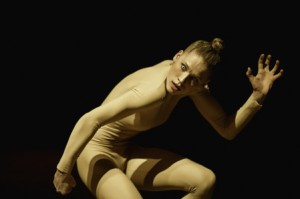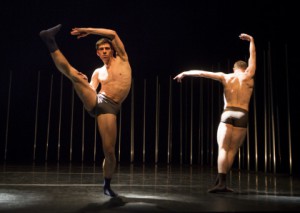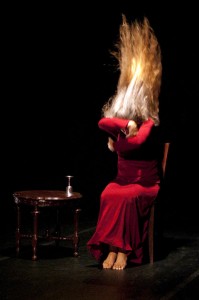By Rachel Straus
Perhaps we are returning to the era of dance as a solo act. That’s what I was thinking while watching the 16-member Nederlands Dans Theater 2. In three of the four works presented at the Joyce Theater on February 7, the ensemble dances devolved into a series of solos. This trend occurred for no apparent reason. Insiders know, however, that it’s a lot easier to make solos than group choreography. Thankfully NDT2 has superb dancers, like the dramatic Imre Van Opstal and the inimitable Spencer Dickhaus. So this tendency to load up an evening with solo dance sections isn’t a tragedy. But I nonetheless left Saturday night’s show feeling empty-handed. The ideas in the presented works, made between 2003 and 2013, are light or just insignificant. Some are plain dated, like Sara by Sharon Eyal and Gal Behar, which is about how we are becoming mechanized by our machines.
NDT2’s look-at-me-now style choreographies, under the direction of Paul Lightfoot and his artistic partner Sol León, stand in stark contrast to the former NDT2 seen five years ago under the direction of Jiri Kylian. This Czech choreographer was responsible for putting NDT2, composed of dancers under age 27, on the international dance map through his choreographies that combined the communitarian qualities of the folk, the elegance of ballet, and the experimentalism of modern dance. As a result of Kylian’s ensemble dances, one reveled in NDT dancers’ multiple strengths, which included their partnering, solo and group dancing, as well as their ability to become symbolic figures in an architecturally complex landscape, framed and influenced by a well-chosen piece of music.
With the exception of Johan Inger’s I New Then (2012), set to some of Van Morrison’s greatest hits, the two other ballets employing music in the program responded to their scores like background sound. Indeed, the work that used no music was the best of the lot. In Shutters Shut (2003) danced by Dickhaus and Opstal, the choreographers León and Lightfoot developed and set their duet to Getrude Steins’ poem, “If I told him: A completed portrait of Picasso” (1923). In the poem, Stein replicates the fracturing of an image into jagged shapes, seen in Picasso’s cubist paintings, through her repetitious and abrupt prose style. Lightfoot and León, in turn, fracture gender norms: Dickhaus wears red lipstick, his expression is a cross between Betty Boop and Garbo, and he knows how to jut a hip. Meanwhile Opstal moves with the masculine force of Mussolini, and her black eye makeup makes her look like a modernist guerilla fighter. The costumes are clever too: they resemble corset-cum-wrestling skins; the fronts of them are white and the backs are black, thus causing the backside of the dancers to disappear into the black backdrop hanging at the lip of the stage. When Dickhaus and Opstal traverse from stage right to left, the work ends. No more than four minutes, Shutters Shut is a morsel of creativity. What’s more, the dancers need each other to successfully complete the work. Their comic timing and opposing interpretations of the same quirky gestures transform them into freakish twins. Their dancing is marvelous and, for this viewer, it says something more than “look at me.”


